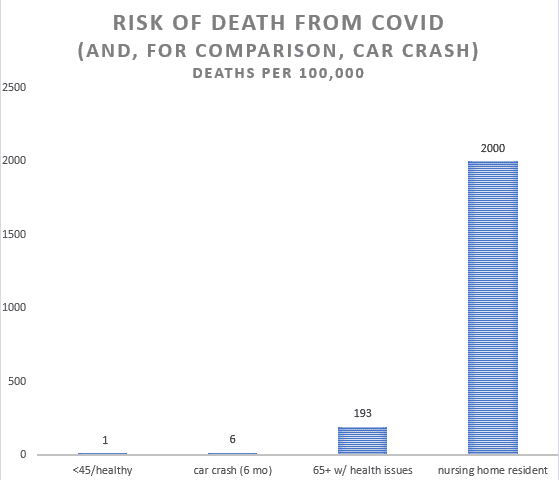In 1998, Craig Fox and Amos Tversky reported on a survey in which U.S. basketball fans were asked to judge the probability that each of 8 teams might win the championship. Students of statistics can probably guess the outcome – the probabilities for all the teams taken together not only exceeded 1 (a logical impossibility), but they exceeded 2, averaging 2.4. If the fans had placed bets derived from their probability estimates, the money they’d have made off the winner ($160) would have been dwarfed by the losses on the other bets ($287) – they were guaranteed to lose substantial money. Daniel Kahneman, in Thinking Fast and Slow, notes two phenomena at work:
- People tend to overestimate the probability of unlikely events, and
- In decision-making, people tend to overweight the importance of unlikely events
Does this apply to perceptions about Covid-19? On the face of it, getting Covid-19 is an unlikely event – an overall probability of 0.5% in the U.S. as of the end of May. Are people overestimating chances of getting it? Are fear and panic creating greater catastrophe by throwing the world into a depression? Previous flu pandemics in 1957 and 1968 killed many people but did not engender the same degree of panic as has Covid-19. The numbers killed were somewhat smaller, but the economic impact of those pandemics was nil, compared to the major dislocation of the current pandemic.
Covid-19 fears certainly dominate the news and public policy debates. Consider a key group through which we get much of our Covid-19 perceptions – newsroom analysts and reporters. They bring us a worldview of infection facing us at every turn, and naturally gravitate towards the warp and woof of journalism – stories of human tragedy, and statistics that alarm. But how does this accord with their own actual world?
The average age of journalists is less than 45 (see this source). Healthy people aged 44 and younger have by far the lowest Covid-19 risk – a death rate on the order of 1 in 100,000 (see this blog for more). Compare this to the general population risk of death in a car accident – about 6 in 100,000 over the course of six months (source here).
But now consider a different group – folks older than 65, with one or more complicating health conditions. For them, the risk of death from Covid-19 is more than 400 times greater – about 435 in 100,000, or 0.43%. This, though, should be put in the perspective of their overall risk of death from any cause – a 70-year-old has a 1.9% chance of dying from all non-Covid-19 causes before they turn 71. It is unlikely the two risks are fully additive – for some of those who are destined to be in the 1.9%, Covid-19 may end up being the cause of death (i.e. displacing pneumonia or some other cause).
And consider yet another group – residents of nursing homes. A significant portion of Covid-19 deaths – over a third, by some estimates – are tied to nursing homes. The total number of confirmed (end-May) Covid-19 deaths in the US is over 100,000. The number of current nursing home residents is 1.6 million (according to the CDC), so if a third of US Covid-19 deaths are in nursing homes the risk of death there is over 2% – odds that are looking quite short.
So the realities of Covid-19 risk, as opposed to the perception, are quite varied by age and medical circumstance:

You might conclude from this that a logical strategy is to isolate the old and unhealthy, particularly those in nursing homes, from the less vulnerable population. But those over 65 with some form of health condition comprise 12% of the US population – over 42 million people. Isolating them to protect them is a logistical and ethical challenge. How to handle their relationships with loved ones, students, friends, etc., who are not part of the isolated group?
Conclusion
It seems likely that the bulk of the population is overestimating their own risk from Covid-19. This is not the classic overestimation problem – certain segments of the population do indeed have a relatively high Covid-19 risk, a risk with major consequences. Rather, it seems that most people have difficulty coming to grips quantitatively with the huge imbalance in risk between younger healthy people (for whom Covid-19 is on the order of other common risks faced daily), and older/unhealthy people for whom Covid-19 is a significant threat, outpacing all other threats.